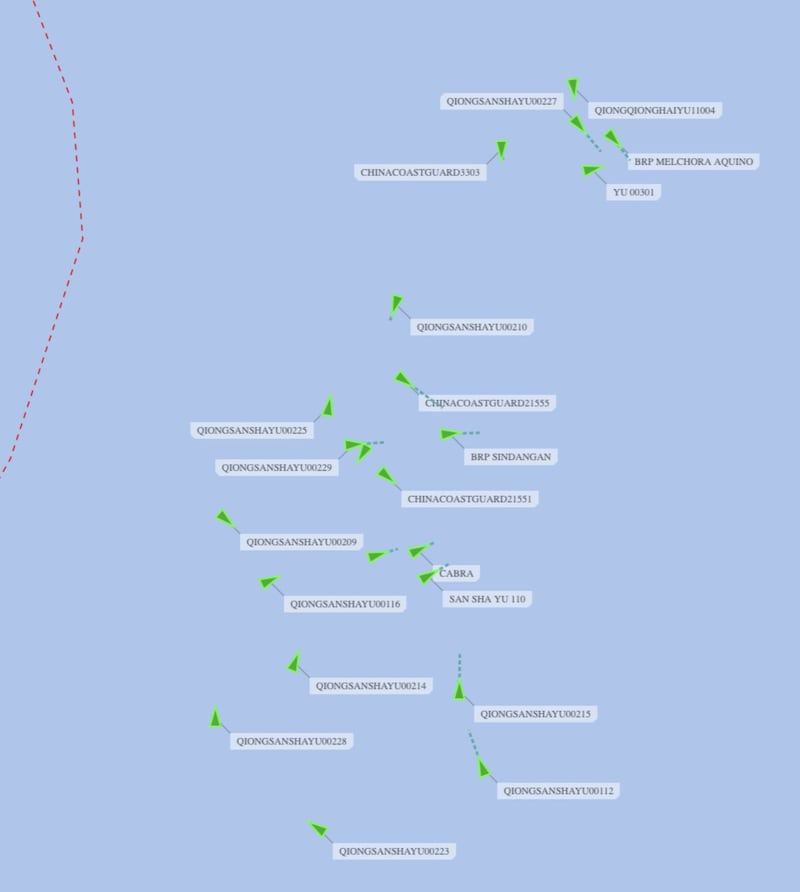China was once again trying to block Philippine ships from delivering supplies to the troops stationed at the Second Thomas Shoal in the South China Sea on Friday.
Earlier in the day, "China Coast Guard (CCG) and Chinese Maritime Militia (CMM) vessels recklessly harassed, blocked, executed dangerous maneuvers in another attempt to illegally impede or obstruct a routine resupply and rotation mission to BRP Sierra Madre (LS 57) at Ayungin Shoal (Second Thomas Shoal)," the National Task Force for the West Philippine Sea said in a statement. The West Philippine Sea is the name that Filipinos use for waters claimed by Manila in the South China Sea.
“CCG vessel 5203 deployed water cannon against Philippine supply vessel M/L Kalayaan,” it said. M/L, or motor launch, implies a small-sized, motor-powered boat.
The Kalayaan and another supply boat, the Unaizah Mae 1, were “also subjected to extremely reckless and dangerous harassment at close proximity” by Chinese vessels inside the shoal’s lagoon during their approach to BRP Sierra Madre, said the Philippine National Task Force.
“Nonetheless, both supply boats were able to successfully reach LS 57 (BRP Sierra Madre),” it said.
“We condemn, once again, China’s latest unprovoked acts of coercion and dangerous maneuvers … that has put the lives of our people at risk.”
Manila deliberately ran the World War II-era Sierra Madre aground in 1999 to serve as its outpost at the shoal and has to dispatch ships on a regular basis to deliver fresh supplies to the military personnel there.
The Philippines’ rotation and resupply (RoRe) missions have recently been increasingly impeded and blocked by Chinese ships.

In a graphic provided by Ray Powell from the U.S. Gordian Knot Center for National Security Innovation, Philippine Coast Guard ships accompanying the two supply boats were surrounded by a large number of Chinese vessels.
“In total, 24 Chinese ships were involved in the incident, including four Coast Guard ships. The rest were maritime militia ships,” Powell said.
Continuing blockade
“Beijing is testing Manila’s nerves,” said Malcolm Davis, a defense analyst at the Australian Strategic Policy Institute (ASPI).
“China will keep on conducting such blockades with the hope that Manila will give up its RoRe missions but it won’t happen,” Davis told Radio Free Asia.
When and how the United States, the Philippines’ treaty ally, will get involved remains to be seen, according to the analyst. By a mutual defense treaty, Washington is obliged to defend its ally in the case the latter is being attacked.
The U.S. has repeatedly said that Article IV of the 1951 U.S.-Philippines Mutual Defense Treaty “extends to armed attacks on Philippine armed forces, public vessels, and aircraft – including those of its Coast Guard – anywhere in the South China Sea.”
The Chinese Coast Guard quickly issued a statement calling Manila's mission "illegal."
Spokesperson Gan Yu said that “two small transport ships and three coast guard ships from the Philippines entered the waters adjacent to Ren'ai Reef (Chinese name for Second Thomas Shoal) in China's Nansha (Spratly) Islands without permission from the Chinese government.”
“The Chinese Coast Guard follows Philippine ships in accordance with the law, takes control measures, and makes temporary special arrangements for the Philippines to transport food and other necessary daily supplies,” Gan said.
“The Philippines' actions violate China's territorial sovereignty, violate the Declaration on the Conduct of Parties in the South China Sea, and violate its own commitments,” he said, “We urge the Philippines to immediately stop its infringing actions.”
For its part, Manila said the Philippine Embassy in China “has demarched the Chinese foreign ministry and protested” against China’s actions.
As of Nov. 7, the Philippines has made 58 diplomatic protests against what it sees as China’s violations of its sovereignty in the South China Sea.
Last month Manila summoned the Chinese ambassador to the Philippines to protest over two similar incidents, one of which led to a small collision of ships.
Second Thomas Shoal is about 200 kilometers (124 miles) from the Philippine island of Palawan, and more than 1,000 kilometers from China’s Hainan island. It is claimed by the Philippines, China, Vietnam and Taiwan, but is located inside the Philippines’ exclusive economic zone (EEZ).
Edited by Mike Firn and Elaine Chan.
BenarNews is an RFA-affiliated online news organization.
